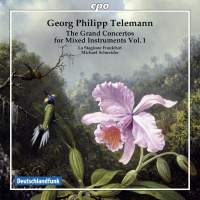Texte paru dans: / Appeared in: |
|
|
Outil de traduction (Très approximatif) |
|
|
|
|
|
Reviewer: Barry
Brenesal I can understand wanting to find a short description for this new Telemann series by Schneider and La Stagione Frankfurt, but “grand concertos” or concerto grossi for mixed instruments is a bit of a misnomer when applied to all of these works. Some, such as TWV 54:B1, fit the category, pitting a varied concertino against ripieno. Others, however, such as the Concerto for Two Trumpets, Two Oboes, and Strings (TWV deest) simply add their soloists within the larger body of performers, making them effectively ripieno concerti, intended in Telemann’s case usually as operatic sinfonia (the ancestor of the three-movement Italian symphony). It doesn’t clarify matters to try and separate by broadly national styles, since Telemann utilized Italian, French, and North German traits with ease, and sometimes in quick succession in single works, as in TWV 53:D3—actually the introductory sinfonia to his opera Die Ende der Babylonischen Monarchie oder Belsazer. If you do enjoy playing “what style is he going to ingeniously introduce next?” games with Telemann, you will in any case have a field day with this release. The strict fugue of the first allegro from TWV 54:B1, for example, leads into a set of Italianate variations for the soloists over a siciliano rhythm for the ripieno, which in turn leads to a rapid folk dance with offbeat accents, much in the composer’s Silesian manner. The TWV deest work begins with what sounds like a French overture, but displaces the usual fugal or fast dance central section with a brief, slow Italianate aria employing the freer phrasing possibilities of recitative rhythms. If the third movement of TWV 53:E1 offers delicate textures that resemble those of Rameau’s Pièces de clavecin en concerts, the final concerto on the disc, TWV 50:3, is a polyphonic work of many a fugue, canon, and imitative point, looking back to the 16th century, even if the models move between the Italian States and the North German States. If nothing else, this music furnishes yet another needed corrective to the idea that Baroque forms were strictly adhered to. Various composers regularly show this not to be the case, but Telemann heads the list when it comes to confounding expectations with ingenuity and (on occasion) humor. In a review of symphonies by Gaspard Fritz (CPO 777696; Fanfare 37:1), I pointed to Schneider’s ability to balance his forces “without losing sight of the distinct, unblended mix of colors in the period’s orchestra,” and that “La Stagioni Frankfurt’s strings have a wiry, raw sound, but they play expertly.” Both remarks hold true for this release. Arguably it is Schneider’s best, in that it allows full reign to his sense of color in a mixed or broken ensemble, without being compromised by inadequate vocalists. It also shows all the attention to detail of which he is capable, repeating sections with light, appropriate ornamentation, and allowing his soloists plenty of space in which to allow Telemann’s carefully worked textures to shine. The engineering is full and forward, without any of the large hall or cathedral acoustic that several Baroque ensembles use to give their sound more body. Nothing of the kind is necessary, here. In short, highly recommended. | |
|
|
|
|
Cliquez l'un ou l'autre
bouton pour découvrir bien d'autres critiques de CD |
|




